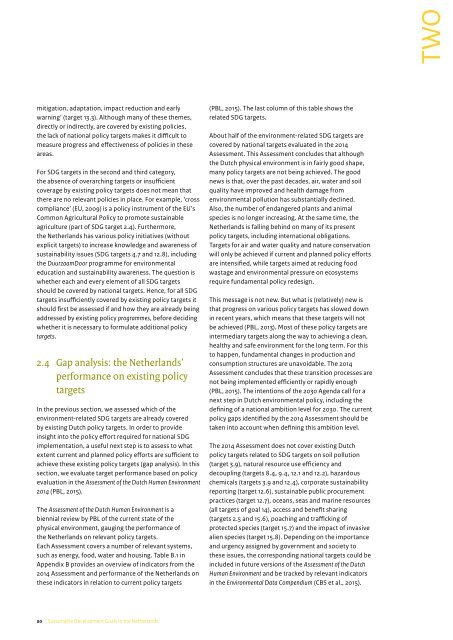Sustainable Development Goals in the Netherlands
pbl-2016-sustainable-development-in-the-Netherlands_1966
pbl-2016-sustainable-development-in-the-Netherlands_1966
Create successful ePaper yourself
Turn your PDF publications into a flip-book with our unique Google optimized e-Paper software.
two<br />
mitigation, adaptation, impact reduction and early<br />
warn<strong>in</strong>g’ (target 13.3). Although many of <strong>the</strong>se <strong>the</strong>mes,<br />
directly or <strong>in</strong>directly, are covered by exist<strong>in</strong>g policies,<br />
<strong>the</strong> lack of national policy targets makes it difficult to<br />
measure progress and effectiveness of policies <strong>in</strong> <strong>the</strong>se<br />
areas.<br />
For SDG targets <strong>in</strong> <strong>the</strong> second and third category,<br />
<strong>the</strong> absence of overarch<strong>in</strong>g targets or <strong>in</strong>sufficient<br />
coverage by exist<strong>in</strong>g policy targets does not mean that<br />
<strong>the</strong>re are no relevant policies <strong>in</strong> place. For example, ‘cross<br />
compliance’ (EU, 2009) is a policy <strong>in</strong>strument of <strong>the</strong> EU’s<br />
Common Agricultural Policy to promote susta<strong>in</strong>able<br />
agriculture (part of SDG target 2.4). Fur<strong>the</strong>rmore,<br />
<strong>the</strong> Ne<strong>the</strong>rlands has various policy <strong>in</strong>itiatives (without<br />
explicit targets) to <strong>in</strong>crease knowledge and awareness of<br />
susta<strong>in</strong>ability issues (SDG targets 4.7 and 12.8), <strong>in</strong>clud<strong>in</strong>g<br />
<strong>the</strong> Duurzaam Door programme for environmental<br />
education and susta<strong>in</strong>ability awareness. The question is<br />
whe<strong>the</strong>r each and every element of all SDG targets<br />
should be covered by national targets. Hence, for all SDG<br />
targets <strong>in</strong>sufficiently covered by exist<strong>in</strong>g policy targets it<br />
should first be assessed if and how <strong>the</strong>y are already be<strong>in</strong>g<br />
addressed by exist<strong>in</strong>g policy programmes, before decid<strong>in</strong>g<br />
whe<strong>the</strong>r it is necessary to formulate additional policy<br />
targets.<br />
2.4 Gap analysis: <strong>the</strong> Ne<strong>the</strong>rlands’<br />
performance on exist<strong>in</strong>g policy<br />
targets<br />
In <strong>the</strong> previous section, we assessed which of <strong>the</strong><br />
environment-related SDG targets are already covered<br />
by exist<strong>in</strong>g Dutch policy targets. In order to provide<br />
<strong>in</strong>sight <strong>in</strong>to <strong>the</strong> policy effort required for national SDG<br />
implementation, a useful next step is to assess to what<br />
extent current and planned policy efforts are sufficient to<br />
achieve <strong>the</strong>se exist<strong>in</strong>g policy targets (gap analysis). In this<br />
section, we evaluate target performance based on policy<br />
evaluation <strong>in</strong> <strong>the</strong> Assessment of <strong>the</strong> Dutch Human Environment<br />
2014 (PBL, 2015).<br />
The Assessment of <strong>the</strong> Dutch Human Environment is a<br />
biennial review by PBL of <strong>the</strong> current state of <strong>the</strong><br />
physical environment, gaug<strong>in</strong>g <strong>the</strong> performance of<br />
<strong>the</strong> Ne<strong>the</strong>rlands on relevant policy targets.<br />
Each Assessment covers a number of relevant systems,<br />
such as energy, food, water and hous<strong>in</strong>g. Table B.1 <strong>in</strong><br />
Appendix B provides an overview of <strong>in</strong>dicators from <strong>the</strong><br />
2014 Assessment and performance of <strong>the</strong> Ne<strong>the</strong>rlands on<br />
<strong>the</strong>se <strong>in</strong>dicators <strong>in</strong> relation to current policy targets<br />
(PBL, 2015). The last column of this table shows <strong>the</strong><br />
related SDG targets.<br />
About half of <strong>the</strong> environment-related SDG targets are<br />
covered by national targets evaluated <strong>in</strong> <strong>the</strong> 2014<br />
Assessment. This Assessment concludes that although<br />
<strong>the</strong> Dutch physical environment is <strong>in</strong> fairly good shape,<br />
many policy targets are not be<strong>in</strong>g achieved. The good<br />
news is that, over <strong>the</strong> past decades, air, water and soil<br />
quality have improved and health damage from<br />
environmental pollution has substantially decl<strong>in</strong>ed.<br />
Also, <strong>the</strong> number of endangered plants and animal<br />
species is no longer <strong>in</strong>creas<strong>in</strong>g. At <strong>the</strong> same time, <strong>the</strong><br />
Ne<strong>the</strong>rlands is fall<strong>in</strong>g beh<strong>in</strong>d on many of its present<br />
policy targets, <strong>in</strong>clud<strong>in</strong>g <strong>in</strong>ternational obligations.<br />
Targets for air and water quality and nature conservation<br />
will only be achieved if current and planned policy efforts<br />
are <strong>in</strong>tensified, while targets aimed at reduc<strong>in</strong>g food<br />
wastage and environmental pressure on ecosystems<br />
require fundamental policy redesign.<br />
This message is not new. But what is (relatively) new is<br />
that progress on various policy targets has slowed down<br />
<strong>in</strong> recent years, which means that <strong>the</strong>se targets will not<br />
be achieved (PBL, 2013). Most of <strong>the</strong>se policy targets are<br />
<strong>in</strong>termediary targets along <strong>the</strong> way to achiev<strong>in</strong>g a clean,<br />
healthy and safe environment for <strong>the</strong> long term. For this<br />
to happen, fundamental changes <strong>in</strong> production and<br />
consumption structures are unavoidable. The 2014<br />
Assessment concludes that <strong>the</strong>se transition processes are<br />
not be<strong>in</strong>g implemented efficiently or rapidly enough<br />
(PBL, 2015). The <strong>in</strong>tentions of <strong>the</strong> 2030 Agenda call for a<br />
next step <strong>in</strong> Dutch environmental policy, <strong>in</strong>clud<strong>in</strong>g <strong>the</strong><br />
def<strong>in</strong><strong>in</strong>g of a national ambition level for 2030. The current<br />
policy gaps identified by <strong>the</strong> 2014 Assessment should be<br />
taken <strong>in</strong>to account when def<strong>in</strong><strong>in</strong>g this ambition level.<br />
The 2014 Assessment does not cover exist<strong>in</strong>g Dutch<br />
policy targets related to SDG targets on soil pollution<br />
(target 3.9), natural resource use efficiency and<br />
decoupl<strong>in</strong>g (targets 8.4, 9.4, 12.1 and 12.2), hazardous<br />
chemicals (targets 3.9 and 12.4), corporate susta<strong>in</strong>ability<br />
report<strong>in</strong>g (target 12.6), susta<strong>in</strong>able public procurement<br />
practices (target 12.7), oceans, seas and mar<strong>in</strong>e resources<br />
(all targets of goal 14), access and benefit shar<strong>in</strong>g<br />
(targets 2.5 and 15.6), poach<strong>in</strong>g and traffick<strong>in</strong>g of<br />
protected species (target 15.7) and <strong>the</strong> impact of <strong>in</strong>vasive<br />
alien species (target 15.8). Depend<strong>in</strong>g on <strong>the</strong> importance<br />
and urgency assigned by government and society to<br />
<strong>the</strong>se issues, <strong>the</strong> correspond<strong>in</strong>g national targets could be<br />
<strong>in</strong>cluded <strong>in</strong> future versions of <strong>the</strong> Assessment of <strong>the</strong> Dutch<br />
Human Environment and be tracked by relevant <strong>in</strong>dicators<br />
<strong>in</strong> <strong>the</strong> Environmental Data Compendium (CBS et al., 2015).<br />
20 | <strong>Susta<strong>in</strong>able</strong> <strong>Development</strong> <strong>Goals</strong> <strong>in</strong> <strong>the</strong> Ne<strong>the</strong>rlands


